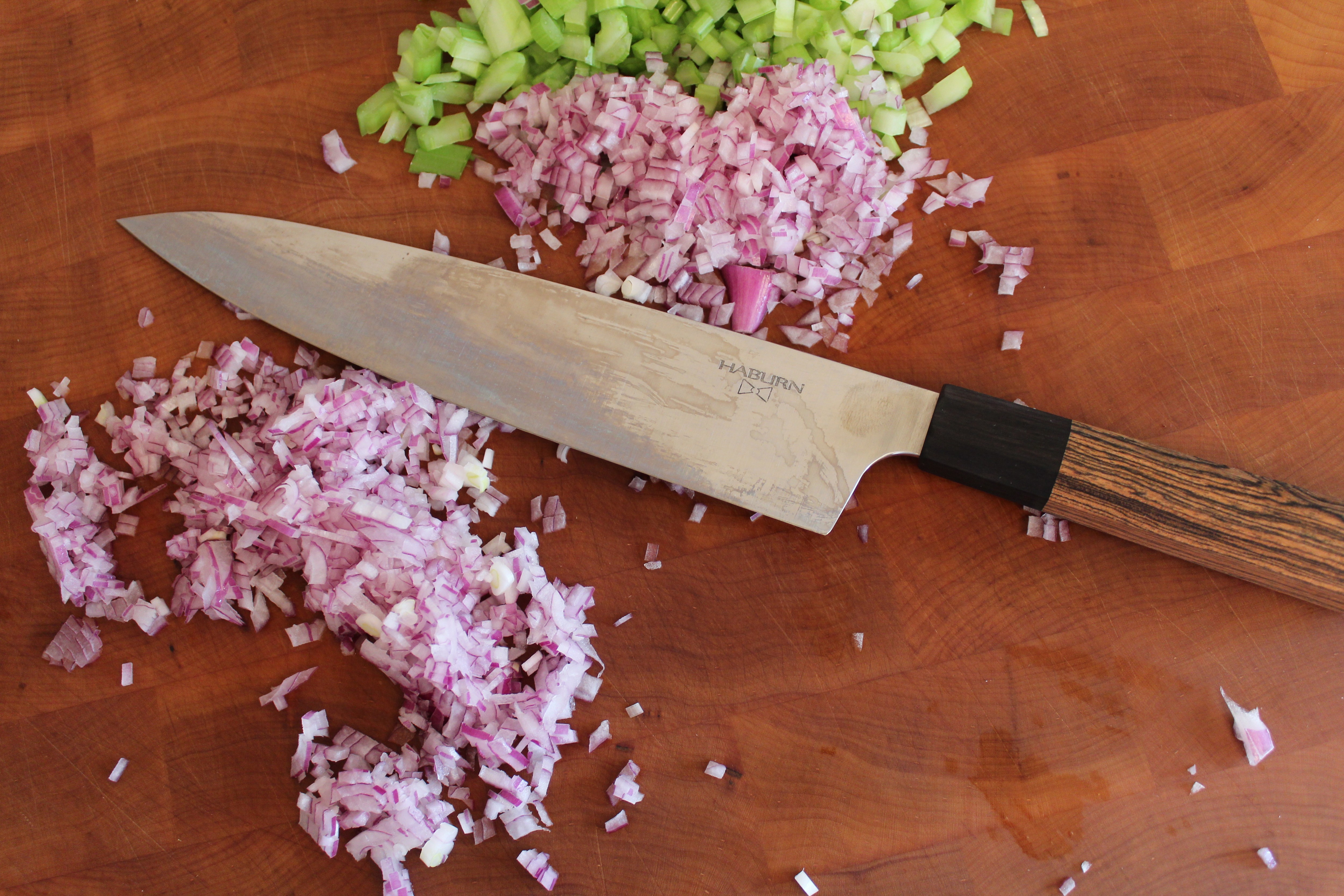Hi,
It took longer (or even much longer) than I ever intended or envisioned, but finally here it comes. My review of a 240 gyuto that I ordered from Ian earlier this year. But as reward I was able to make a short comparison to Kato 240 workhorse - and here comes a big thanks for Matt who kindly offered to lent me his Kato which he uses professionally.
Please do note that I am just a home cook and my experience with Japanese kitchen knives and their maintenance is still limited. I do my best to share my personal opinion, but I am not a pro user or even less someone who makes their living with making or maintaining knives.
Background:
Before I move on with the review I would like to clarify one point. At the point when I was ordering the knife I though I knew what I was looking for. So I specified to Ian that I want a workhorse gyuto with minimal flex and weight not more than 250g. Throughout the order process I concentrated more on the blade profile, handle, etc, but did not really give a though to edge/bevel geometry (I know, I know ..). Ian was ready with the knife rather fast and once I saw the photos I was stunned. Then the knife arrived 2 weeks later and all I could say was "wow". I started to use the knife. First session included only meat slicing and the knife performed flawlessly. But as soon as I tried to go though some (really thick) fresh carrots I realised that I have actually not specified what I meant with that "workhorse" buzzword, but instead somehow expected to get knife that will miraculously cut everything with no resistance or wedging and that it will be flex-free, stiff and at the same time lightweight. OK, that was naive and I should have known better. But my only previous first hand experience was 210mm damascus gyuto which was extremely thin and feather light (though with some flex and tendency to micro chipping and rather poor food release).
So I talked to Ian and he offered to me to thin (I should rather say re-grind) the knife free of charge. Further more after all the grinding he put that beautiful hand-sanded finish on the knife. For various reasons it took me a long time to get the knife shipped, but finally the knife is back and I can fulfil the promise I made a long time ago and write this review.
So - this is the knife we are talking about:

The review:
Before the re-grinding the knife had convex bevels that continued up to the spine. After second iteration the 2/3 of the width of the blade (from the cutting edge) were turned to concave grind, so now the knife has sort of "S" grind - something Ian started to make only recently. The spine was not touched during the re-grind.
The S grind on this knife is relatively gentle and the blade behind the edge is very thin:
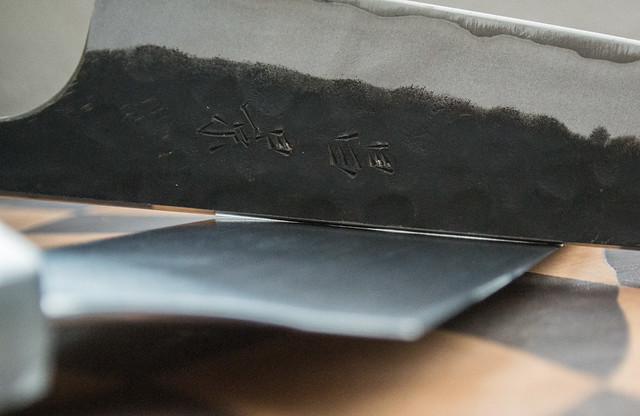
The blade profile (we went thought several versions) was chosen such that there is nearly flat spot at the heel and not too pronounced belly at the tip. At the same time, the tip should not be too high (or too close the the spine), so that tip work does not require pointing the knife downwards too much. As the dimensions and image below show - the distal taper over large part of the blade is not too pronounced - this was the result of wanting the knife to be on the stiff side. Both spine and choil are fully rounded what really adds to how the knife feel in hand. Makes me think that all knives should have this.
The knife is now really thin behind the edge - here the obligatory choil shot:
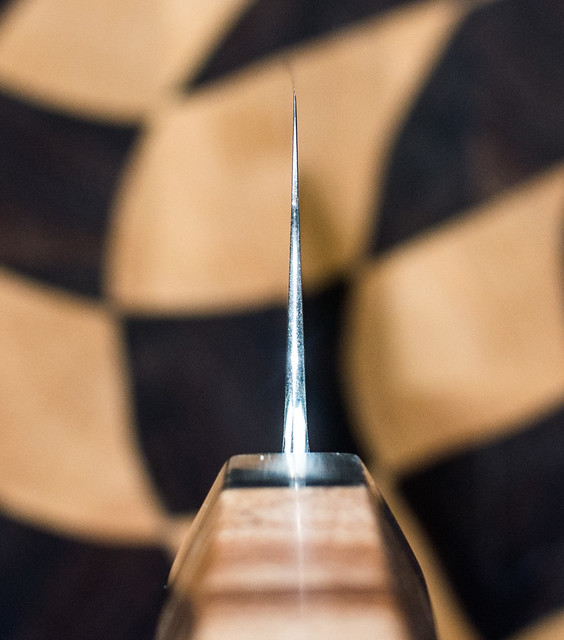
The knife dimensions:
- heel to tip: 240mm
- height at the heel: 48mm
- width of spine at heel: 3.0mm
- width of spine at middle: 2.5mm
- width of spine 1cm from the tip: 0.6mm
- handle height (behind bolster): 25mm
- handle width (behind bolster):19mm
- weight: 217g
The handle material is a nice piece of stabilized maple burl in combination with stainless steel. The F&F is very nice. The handle sits well in hand and allows for a comfortable pinch grip. I found the stabilised wood a bit slippery at first, but yesterday I dicddid to try to put some board butter on the handle and it suddenly feels much better in hand. No - not as 'live' as non stabilised wood does, but still very nice.
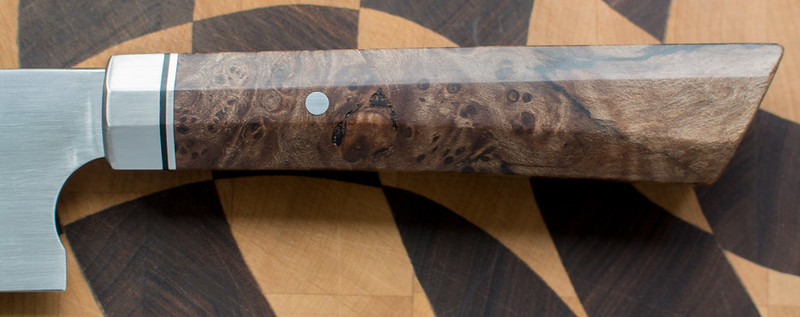
Ian did really a great job on the bolster the fit & finish is excellent, the edges are rounded, the transition to the wooden parts perfectly flush:

Blade finish is very nice too - hand rubbed with 400 grit sandpaper. It is not only looks, but also it is pleasant to hold the blade when using pinch grip. It looks even better in person:
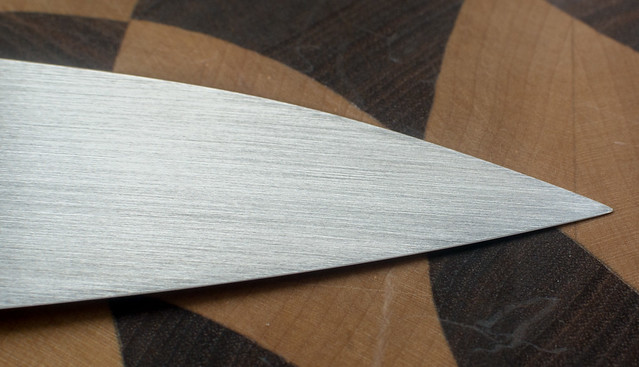
Performance:
This gyuto is my first experience with AEB-L and also my first experience with concave grind. The concave grind allows for a blade that is very thin behind the edge and also stays thin as you move away from the edge. Of course the very few mm behind the edge are a transition from concave towards the edge, otherwise the edge would be razor-like and possibly too weak for use in kitchen. The knife was order to be stiff and since the spine was not touched and so the knife did not change much in this regard. Only last 5cm of the blade show some flex as there the blade tapers more strongly. The thin tip is however very practical - basically falls through onions.
With this grind the knife can go smoothly even large hard vegetables like hokkaido pumpkin (more on that in comparison with Kato below). There is no wedging even on stuff like large carrots or celery.
After the knife arrived it was reasonably sharp, but I took it to stones to see what can I get out of it and how it will feel on stones. The knife was fast and easy to form burr on 2000 and 6000 Gesshin stones. It does not as nice as for example my white#1 Carter, but still OK (and better then something like R2). To de-burr the knife I used the technique Jon described in his videos. It worked perfectly here and it was just few minutes before the blade would cleanly shave arm hair and push-cut paper.
Now a few words on food release. This property is often asked about, but at the same time not easy to test properly, because it depends not only on what (are those potatoes young and full of water, or older and drier?) you are cutting, but also how (slow motion, fast chopping, slightly rocking, etc.). With that in mind - the Haburn is not particularly good at this - the thin and slightly concave blade allows itself for food to stick to it. But at the same time when comparing it to my Carter funayuki, I fail to see much of a difference (this also means that the thin Carter is no king of food release either). I still have to use the knife on larger range of vegetables, but my conclusion so far is - not the best food release I could imagine, but not the worst either.
Since I have the knife for only few weeks and I did not use it extensively yet, I can not comment on the edge retention. But good news is that even going through some tougher stuff I did not see any edge damage or microchipping. So I would assume that HT was done well - and I would not expect any less. It is always hard to test edge retention at home conditions, because you can not simply say how many hours of work it took until the knife needed to be re-sharpened.
Summary:
This gyuto was my first experience with custom made knife - I have also learned a lot in the process of making and communication with Ian was very friendly and also timely. It yielded a very interesting and functional knife that stands out with its design. I would like to thank to Ian at this point - not only it was pleasure to follow the process, Ian also re-ground the blade once I realised that I was off with my idea about the blade profile. This gyuto is now part of the setup. Its position could only be shaken by my growing inclination towards rustic carbon knives (the Carter is to blame for that), but that is to be seen - for now the Haburn rules the knife rack
Any questions left? Just ask
... and now to something completely different ...
Haburn vs Kato:
This is a though one. In a certain sense - all these two knives have in commons is that they are knifes of similar length. The Kato is a heavy weight hand forged san-mai carbon blade with basic WA burned chestnut handle. the Haburn is custom made (but not forged) mono steel stainless knife with hidden tang handle made from stabilised wood. Both knives have VERY different grinds - the Haburn has a rather complicated S grind, while Kato has a convex grind.
So - how do these two knives look side-by-side:
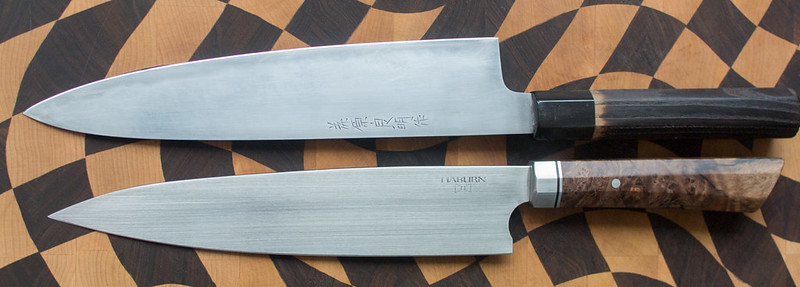
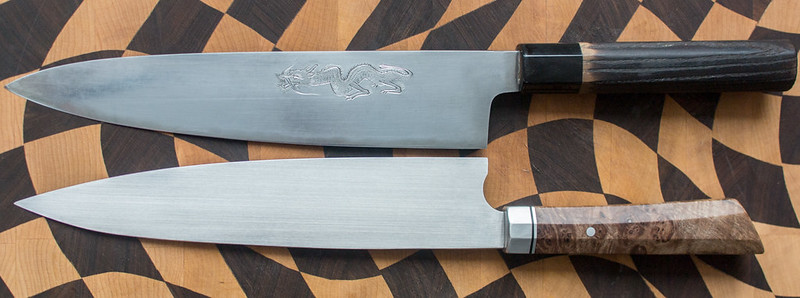
Spine shot - the difference in thickness is staggering:

And here are the tips:
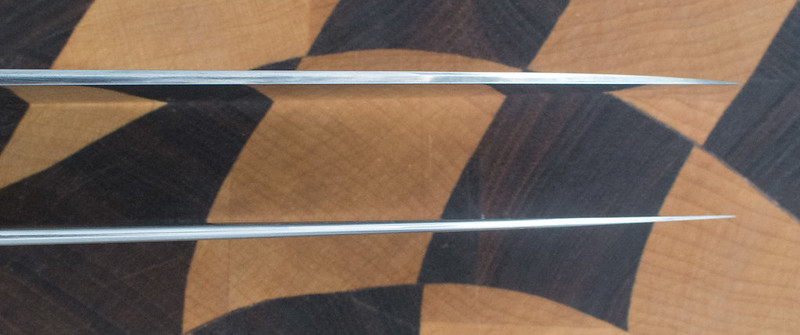
And finally the choil shot. I suppose you can guess which knife is which
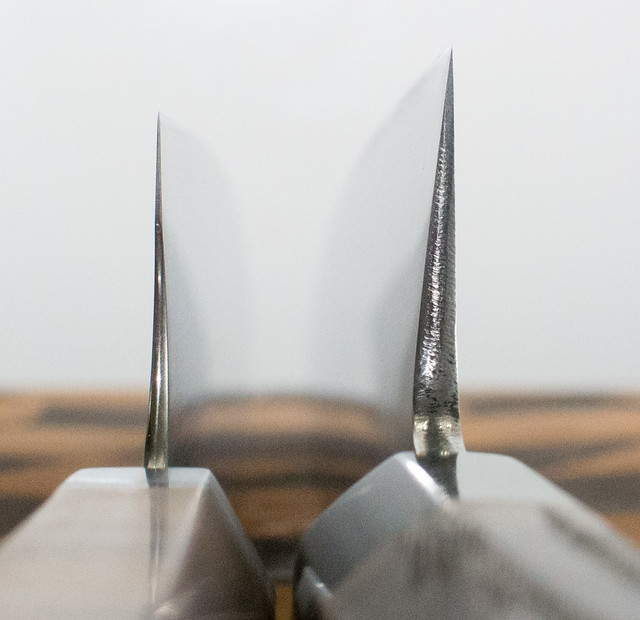
The knives have also quite different finish:
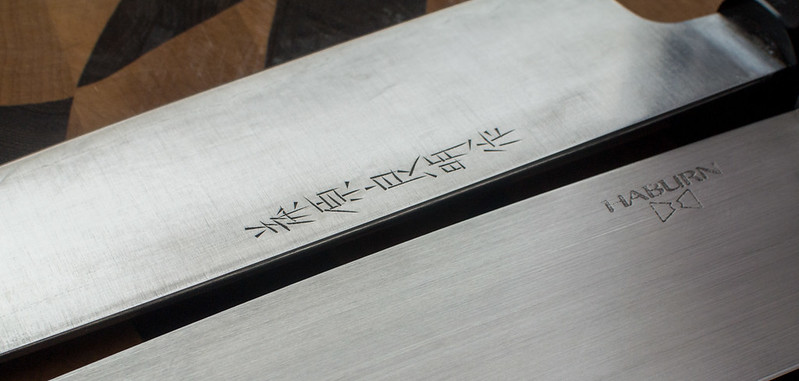
A few words about the Kato first. When I unpacked the knife I immediately had to think of what I read here on KKF - the knife felt more like a weapon, than a kitchen knife. The front-forward centre of mass, the heavy stiff blade, the large size handle (22mm wide and 27mm tall), the greyish blade finish - all of that makes one handle the knife with respect - like it could bite if offended I gave it a quite touch-up on Gesshin 2000 and 6000 stones - the steel is hard, but it was still a quick job. The burr is very fine - in particular with the 6000 stone - one needs to be careful not to 'overlook' it. I proceeded very carefully as I did not want to scratch the blade, but I still got incredibly sharp knife in just few minutes. Not only it shaved hair, it did that extremely smoothly - makes one think that this steel must have very fine grain. The centre of mass is some 4-5cm in from of the handle - in other words, always in front of your grip. With the Haburn the centre of mass is approximately there where you put your index finger with pinch grip. This slight difference of some 2cm makes the two knives feel quite differently in your hand.
I gave it a quite touch-up on Gesshin 2000 and 6000 stones - the steel is hard, but it was still a quick job. The burr is very fine - in particular with the 6000 stone - one needs to be careful not to 'overlook' it. I proceeded very carefully as I did not want to scratch the blade, but I still got incredibly sharp knife in just few minutes. Not only it shaved hair, it did that extremely smoothly - makes one think that this steel must have very fine grain. The centre of mass is some 4-5cm in from of the handle - in other words, always in front of your grip. With the Haburn the centre of mass is approximately there where you put your index finger with pinch grip. This slight difference of some 2cm makes the two knives feel quite differently in your hand.
Anyhow - after final introduction I decided to get some job done with the Kato - sliced a pineapple and some apples. Blade developed patina quickly (more on that in separate thread)
The feeling during cutting is very particular. The blade is relatively thick (for a Japanese kitchen knife), but it still went through apples, onions and potatoes rather smoothly. Not without any resistance, but really smoothly. As mentioned on KKF already - it 'separates' food. I find that description fitting in well. When cutting smaller items like onions the knife felt 'too much' at times. I am not used to this much weight when cutting vegetables - remember - my vegetable knife is Carter with 167mm blade and weight of only 114 gram which is less than half of the Kato. It felt great cutting the pineapple.
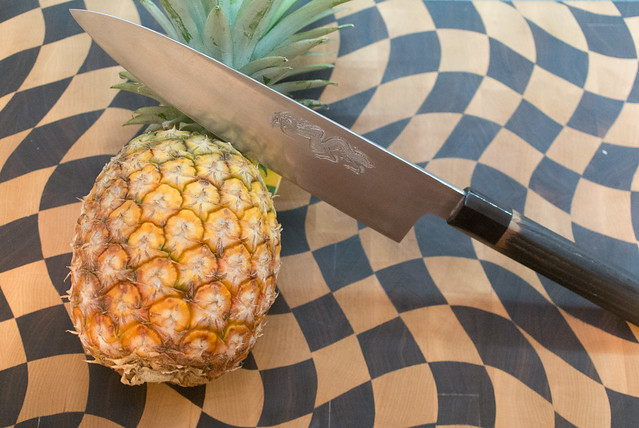
First real cutting comparison with the Haburn came today - two medium sized hokkaido pumpkins were to be diced for a soup. I started with the Kato. What is happening? I had to use both hands to halve the pumpkin. It felt a bit like using an axe. Situation got a little better when I started to cut the halves into some 10-15mm thick slices. Using more slicing that chopping motion allowed to slice the pumpkin and the 'axe feel' got away. Still - it was not particularly pleasant. Chopping the slice proved much more enjoyable. Even though there was some resistance, the weight of the Kato made it easy. Turning to the Haburn gyuto - I could slice the second pumpkin in halves without getting stuck or needing second hand on the blade. I am not saying that there was no resistance, but there was absolutely no wedging. Slicing the halved puking was easy as was rising the slices. Easy.
(This photo was taken before I cleaned that fresh patina off the Kato):
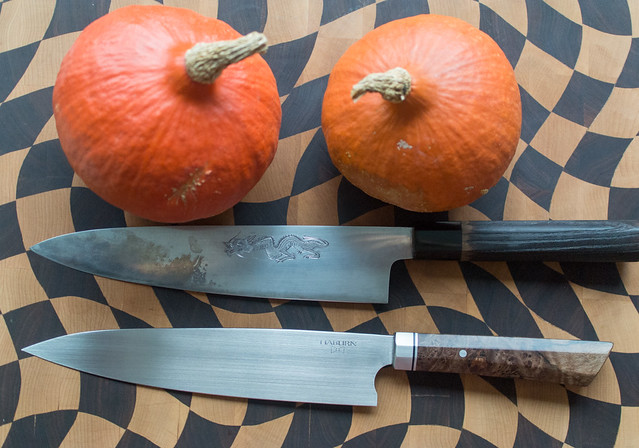
Summary:
As expected - the two knives really are different. Even though the blade shape is not that far apart, the weight distribution and in particular the grind make these knives suitable for different ways how to use them. The Kato really is a workhorse - blade-heavy, goes great through stuff (with some exceptions) and gives very robust feel - a great cutter. The Haburn is more refined with thinner blade (in particular behind the edge) with balance point closer to the handle and slices really well. No, I would not dare to say which is better - it is not quite possible. I only know I would probably prefer to have both
It took longer (or even much longer) than I ever intended or envisioned, but finally here it comes. My review of a 240 gyuto that I ordered from Ian earlier this year. But as reward I was able to make a short comparison to Kato 240 workhorse - and here comes a big thanks for Matt who kindly offered to lent me his Kato which he uses professionally.
Please do note that I am just a home cook and my experience with Japanese kitchen knives and their maintenance is still limited. I do my best to share my personal opinion, but I am not a pro user or even less someone who makes their living with making or maintaining knives.
Background:
Before I move on with the review I would like to clarify one point. At the point when I was ordering the knife I though I knew what I was looking for. So I specified to Ian that I want a workhorse gyuto with minimal flex and weight not more than 250g. Throughout the order process I concentrated more on the blade profile, handle, etc, but did not really give a though to edge/bevel geometry (I know, I know ..). Ian was ready with the knife rather fast and once I saw the photos I was stunned. Then the knife arrived 2 weeks later and all I could say was "wow". I started to use the knife. First session included only meat slicing and the knife performed flawlessly. But as soon as I tried to go though some (really thick) fresh carrots I realised that I have actually not specified what I meant with that "workhorse" buzzword, but instead somehow expected to get knife that will miraculously cut everything with no resistance or wedging and that it will be flex-free, stiff and at the same time lightweight. OK, that was naive and I should have known better. But my only previous first hand experience was 210mm damascus gyuto which was extremely thin and feather light (though with some flex and tendency to micro chipping and rather poor food release).
So I talked to Ian and he offered to me to thin (I should rather say re-grind) the knife free of charge. Further more after all the grinding he put that beautiful hand-sanded finish on the knife. For various reasons it took me a long time to get the knife shipped, but finally the knife is back and I can fulfil the promise I made a long time ago and write this review.
So - this is the knife we are talking about:

The review:
Before the re-grinding the knife had convex bevels that continued up to the spine. After second iteration the 2/3 of the width of the blade (from the cutting edge) were turned to concave grind, so now the knife has sort of "S" grind - something Ian started to make only recently. The spine was not touched during the re-grind.
The S grind on this knife is relatively gentle and the blade behind the edge is very thin:

The blade profile (we went thought several versions) was chosen such that there is nearly flat spot at the heel and not too pronounced belly at the tip. At the same time, the tip should not be too high (or too close the the spine), so that tip work does not require pointing the knife downwards too much. As the dimensions and image below show - the distal taper over large part of the blade is not too pronounced - this was the result of wanting the knife to be on the stiff side. Both spine and choil are fully rounded what really adds to how the knife feel in hand. Makes me think that all knives should have this.
The knife is now really thin behind the edge - here the obligatory choil shot:

The knife dimensions:
- heel to tip: 240mm
- height at the heel: 48mm
- width of spine at heel: 3.0mm
- width of spine at middle: 2.5mm
- width of spine 1cm from the tip: 0.6mm
- handle height (behind bolster): 25mm
- handle width (behind bolster):19mm
- weight: 217g
The handle material is a nice piece of stabilized maple burl in combination with stainless steel. The F&F is very nice. The handle sits well in hand and allows for a comfortable pinch grip. I found the stabilised wood a bit slippery at first, but yesterday I dicddid to try to put some board butter on the handle and it suddenly feels much better in hand. No - not as 'live' as non stabilised wood does, but still very nice.

Ian did really a great job on the bolster the fit & finish is excellent, the edges are rounded, the transition to the wooden parts perfectly flush:

Blade finish is very nice too - hand rubbed with 400 grit sandpaper. It is not only looks, but also it is pleasant to hold the blade when using pinch grip. It looks even better in person:

Performance:
This gyuto is my first experience with AEB-L and also my first experience with concave grind. The concave grind allows for a blade that is very thin behind the edge and also stays thin as you move away from the edge. Of course the very few mm behind the edge are a transition from concave towards the edge, otherwise the edge would be razor-like and possibly too weak for use in kitchen. The knife was order to be stiff and since the spine was not touched and so the knife did not change much in this regard. Only last 5cm of the blade show some flex as there the blade tapers more strongly. The thin tip is however very practical - basically falls through onions.
With this grind the knife can go smoothly even large hard vegetables like hokkaido pumpkin (more on that in comparison with Kato below). There is no wedging even on stuff like large carrots or celery.
After the knife arrived it was reasonably sharp, but I took it to stones to see what can I get out of it and how it will feel on stones. The knife was fast and easy to form burr on 2000 and 6000 Gesshin stones. It does not as nice as for example my white#1 Carter, but still OK (and better then something like R2). To de-burr the knife I used the technique Jon described in his videos. It worked perfectly here and it was just few minutes before the blade would cleanly shave arm hair and push-cut paper.
Now a few words on food release. This property is often asked about, but at the same time not easy to test properly, because it depends not only on what (are those potatoes young and full of water, or older and drier?) you are cutting, but also how (slow motion, fast chopping, slightly rocking, etc.). With that in mind - the Haburn is not particularly good at this - the thin and slightly concave blade allows itself for food to stick to it. But at the same time when comparing it to my Carter funayuki, I fail to see much of a difference (this also means that the thin Carter is no king of food release either). I still have to use the knife on larger range of vegetables, but my conclusion so far is - not the best food release I could imagine, but not the worst either.
Since I have the knife for only few weeks and I did not use it extensively yet, I can not comment on the edge retention. But good news is that even going through some tougher stuff I did not see any edge damage or microchipping. So I would assume that HT was done well - and I would not expect any less. It is always hard to test edge retention at home conditions, because you can not simply say how many hours of work it took until the knife needed to be re-sharpened.
Summary:
This gyuto was my first experience with custom made knife - I have also learned a lot in the process of making and communication with Ian was very friendly and also timely. It yielded a very interesting and functional knife that stands out with its design. I would like to thank to Ian at this point - not only it was pleasure to follow the process, Ian also re-ground the blade once I realised that I was off with my idea about the blade profile. This gyuto is now part of the setup. Its position could only be shaken by my growing inclination towards rustic carbon knives (the Carter is to blame for that), but that is to be seen - for now the Haburn rules the knife rack
Any questions left? Just ask
... and now to something completely different ...
Haburn vs Kato:
This is a though one. In a certain sense - all these two knives have in commons is that they are knifes of similar length. The Kato is a heavy weight hand forged san-mai carbon blade with basic WA burned chestnut handle. the Haburn is custom made (but not forged) mono steel stainless knife with hidden tang handle made from stabilised wood. Both knives have VERY different grinds - the Haburn has a rather complicated S grind, while Kato has a convex grind.
So - how do these two knives look side-by-side:


Spine shot - the difference in thickness is staggering:

And here are the tips:

And finally the choil shot. I suppose you can guess which knife is which

The knives have also quite different finish:

A few words about the Kato first. When I unpacked the knife I immediately had to think of what I read here on KKF - the knife felt more like a weapon, than a kitchen knife. The front-forward centre of mass, the heavy stiff blade, the large size handle (22mm wide and 27mm tall), the greyish blade finish - all of that makes one handle the knife with respect - like it could bite if offended
Anyhow - after final introduction I decided to get some job done with the Kato - sliced a pineapple and some apples. Blade developed patina quickly (more on that in separate thread)
The feeling during cutting is very particular. The blade is relatively thick (for a Japanese kitchen knife), but it still went through apples, onions and potatoes rather smoothly. Not without any resistance, but really smoothly. As mentioned on KKF already - it 'separates' food. I find that description fitting in well. When cutting smaller items like onions the knife felt 'too much' at times. I am not used to this much weight when cutting vegetables - remember - my vegetable knife is Carter with 167mm blade and weight of only 114 gram which is less than half of the Kato. It felt great cutting the pineapple.

First real cutting comparison with the Haburn came today - two medium sized hokkaido pumpkins were to be diced for a soup. I started with the Kato. What is happening? I had to use both hands to halve the pumpkin. It felt a bit like using an axe. Situation got a little better when I started to cut the halves into some 10-15mm thick slices. Using more slicing that chopping motion allowed to slice the pumpkin and the 'axe feel' got away. Still - it was not particularly pleasant. Chopping the slice proved much more enjoyable. Even though there was some resistance, the weight of the Kato made it easy. Turning to the Haburn gyuto - I could slice the second pumpkin in halves without getting stuck or needing second hand on the blade. I am not saying that there was no resistance, but there was absolutely no wedging. Slicing the halved puking was easy as was rising the slices. Easy.
(This photo was taken before I cleaned that fresh patina off the Kato):

Summary:
As expected - the two knives really are different. Even though the blade shape is not that far apart, the weight distribution and in particular the grind make these knives suitable for different ways how to use them. The Kato really is a workhorse - blade-heavy, goes great through stuff (with some exceptions) and gives very robust feel - a great cutter. The Haburn is more refined with thinner blade (in particular behind the edge) with balance point closer to the handle and slices really well. No, I would not dare to say which is better - it is not quite possible. I only know I would probably prefer to have both





